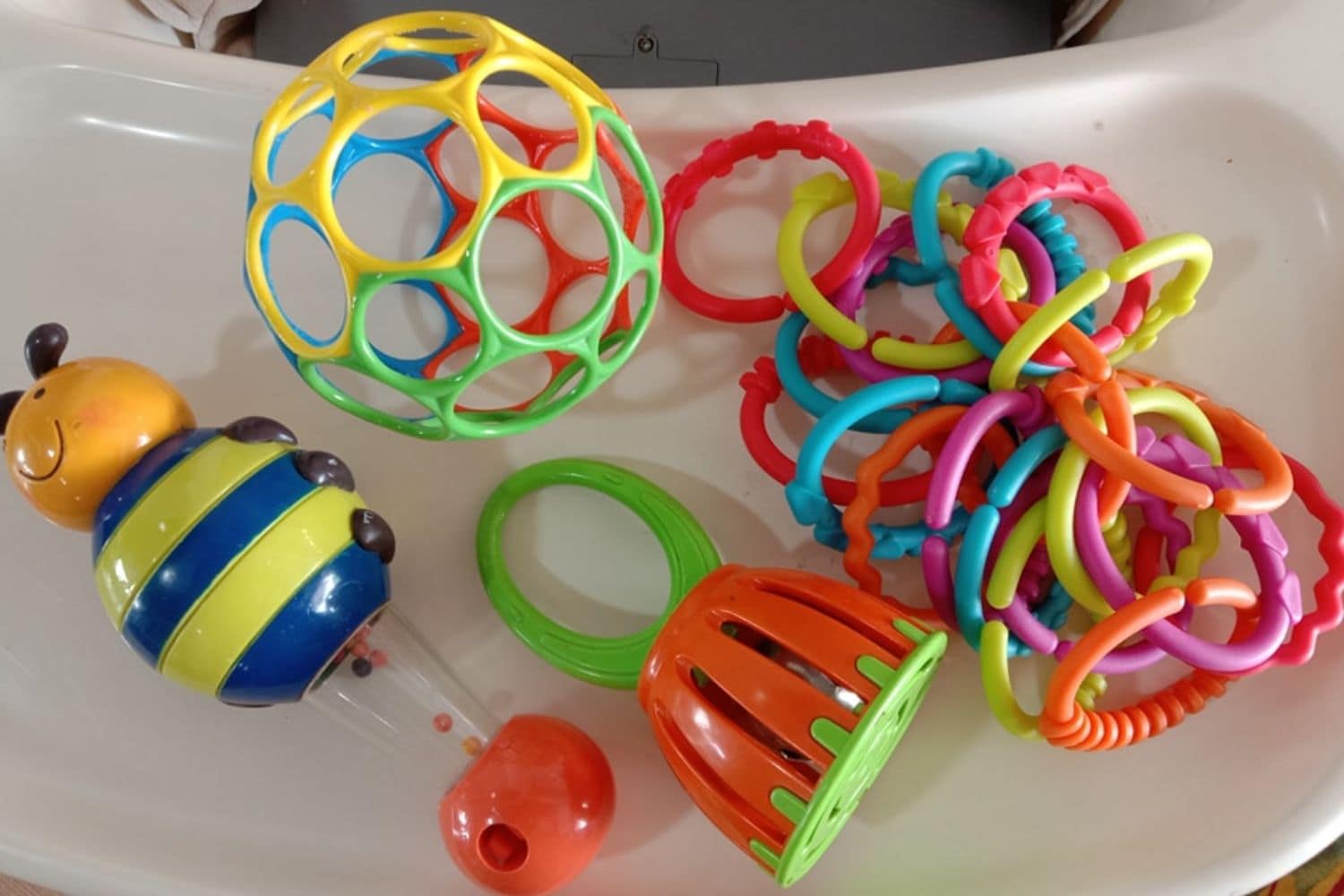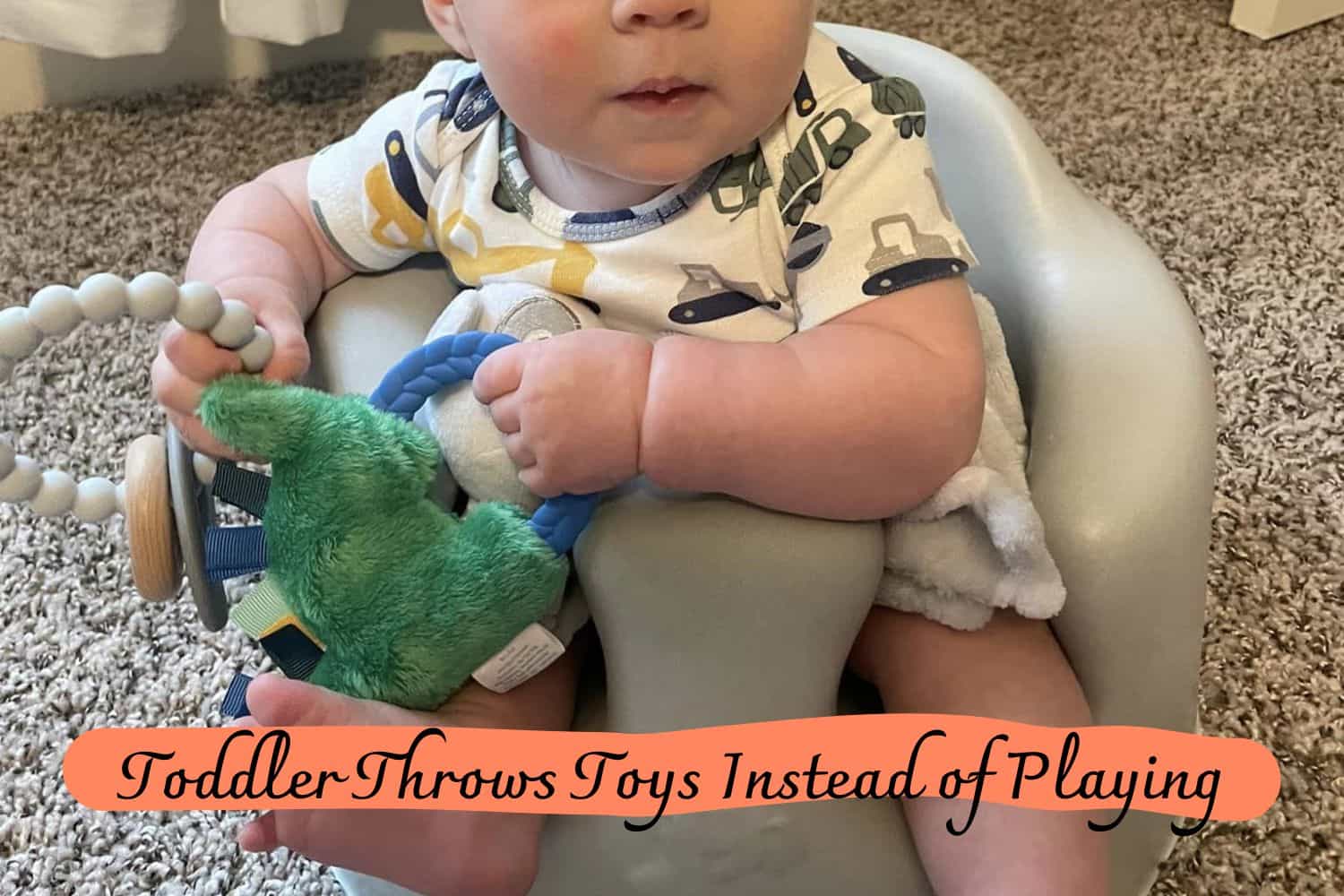Wondering why your toddler throws toys instead of playing with them? We’ve got the answers and strategies to help you understand and put an end to this behavior.
Why Your Toddler Throws Toys Instead of Playing
Are you feeling exasperated and stressed from all the toy tossing, screaming, and temper tantrums your toddler is throwing? Have you ever asked yourself “Why does my toddler keep throwing his toys instead of playing with them?”
While it can seem overwhelming at the moment, understanding why your little one engages in this behavior is key to turning those chaotic moments into peaceful playtime.
In this blog post, we’ll dive deep into the psychology of why a toddler throws toys instead of playing and provide tips on how to tackle these behaviors head-on.
Read on to learn how to help your child transition from just throwing stuff around to engaging in meaningful play!
Is it a cause for concern when my toddler throws toys?
Rest assured, there’s no need to worry. It’s completely normal for toddlers to engage in toy-throwing instead of playing with them.
This behavior is a part of what early childhood educators refer to as the trajectory schema. Schemas are recognized patterns of behavior that have been observed in young children during play.
To put your mind at ease, rest assured that throwing toys is a normal developmental milestone. It even has a name in the medical literature – casting. Around the age of 12 months, there are various milestones you can expect from your child, and this behavior is one of them.
During a developmental assessment for a child of this age, we specifically check to see if they are capable of throwing a block or a ball, rather than simply dropping it from their hands. So, while it may be frustrating for us as parents, this behavior is an important test of their motor skills!
Important note: If you have an older child who consistently throws things, it’s advisable to discuss this with your pediatrician.
Regardless of age, your child needs to engage with their toys in different ways. If throwing is the only thing they do with their toys and they don’t demonstrate any other play behaviors, it’s worth mentioning this to your pediatrician as well.
When do babies start throwing things?
At around 12 months of age, babies begin throwing things. This is a crucial stage in their development, as they start to grasp the concept of object permanence. They understand that objects continue to exist even when they are not visible.
Before this milestone, babies and toddlers are unaware of the reason why things fall instead of up, or why they make noise upon impact.
By approximately 18 months old, children gain more control over their muscles and coordination. As a result, they may be able to throw objects farther distances than before.
It’s worth noting that your child’s throwing behavior may also serve as a form of communication or a means of exploring the trajectory schema.
Reasons Why Toddler Throws Toys Instead of Playing
Developing Motor Skills in Toddlers: The Importance of Play
Discover the vital role playtime holds in fostering motor skill development and hand-eye coordination in young children. Like mastering shooting a basketball or hitting a tennis ball, toddlers learn and grow through play. Start building a strong foundation for their future success today.
Exploring Curiosity: Unleashing Your Toddler’s Inner Scientist
Between 8-12 months of age, toddlers are filled with endless curiosity and a thirst for knowledge. Their little brains buzz with questions, and they embark on a mission to seek answers themselves.
Picture this: your toddler wonders if their favorite doll will cry when thrown against the wall. It may seem like simple mischief, but it’s an important part of their cognitive development. They’re not just misbehaving – they’re craving knowledge about cause and effect.
Moreover, toddlers are constantly learning about cause and effect. In many ways, they resemble young scientists, conducting experiments to understand the world around them. Psychologist Jean Piaget referred to this as a tertiary circular reaction, and it exemplifies the inquisitiveness of toddlers.
And let’s not forget the joy of play. Throwing toys is a form of play known as the trajectory schema, which toddlers adore. So, instead of scolding them for “not playing with their toys,” embrace the fact that your child is engaging in a unique form of play – one that involves tossing and exploring.
Encourage their inquisitive nature and let their inner scientist shine. It’s through these little experiments and adventures that your toddler grows and learns, one question at a time.
Understanding Object Permanence: A Crucial Cognitive Milestone
Discover the fascinating concept of object permanence and how it shapes your child’s perception of the world. From the age of 8-10 months, your little one begins to grasp the notion that things continue to exist even when out of sight. Witness the joy as they throw a toy and eagerly confirm its presence on the floor.
Uncover how this cognitive milestone lays the foundation for the timeless game of peekaboo. Join us in unraveling the wonders of your child’s developing mind.
It’s All About Fun and Exploration
Have you ever wondered why your child loves to throw toys? It turns out, there’s a fascinating reason behind it. Toddlers get easily bored with the same activities and toys over and over again. So, they naturally start experimenting with different ways to play and interact with their toys.
Here’s the thing – a toddler’s way of thinking is quite different from ours. They crave novelty and love breaking patterns. That’s why throwing a toy can bring a whole new level of enjoyment for them. It’s like their own little way of innovating and discovering something new.
And here’s the interesting part: if they find throwing a toy fun, they’re more likely to do it again. It’s all about the laughter and excitement they experience when they watch a toy fly through the air.
So, the next time your toddler throws a toy, remember that it’s not just random mischief. It’s their way of having a blast and exploring the world around them. Embrace the fun and let their imagination soar!
Expressing Emotions
Mastering the art of expressing emotions is a skill that takes time to develop. Even at a young age, toddlers find alternative ways to communicate their happiness, distress, fear, sadness, or disgust.
As human beings, we all encounter feelings of frustration, distress, or anger from early infancy onwards. It’s important to have an outlet for expressing these negative emotions.
Throwing objects can sometimes be a way of releasing anger, grief, or frustration, especially when a toddler lacks other methods of communication due to discomfort or hunger.
If your toddler frequently throws toys, it may be a sign that they need help in finding alternative ways to express their emotions. Consider purchasing calming toys and exploring strategies to assist your toddler in expressing their feelings more effectively.
Effective Communication Techniques for Children: The Art of Getting Attention
Young children, aged 1 or 2, naturally crave attention but cannot express their needs. As a result, they often resort to tantrums or throwing things to capture our attention, even if it’s negative.
The act of throwing objects is a behavior that consistently grabs our focus. When children realize its success, they will use it as a recurring tactic, especially when their parents are engrossed in work or conversation.
Understanding the nuances of children’s attention-seeking behaviors is crucial for effective communication. Let’s explore strategies to foster healthier interactions with our little ones.
Understanding Child Development: Exploring Toddler Behavior
As parents, it’s important to recognize that toddlers often exhibit unconventional behavior due to their limited understanding of objects and actions.
One common scenario is when a toddler observes someone else, like an older child, throwing a frisbee. This can lead to them imitating this action and inadvertently tossing any round item they come across out of a window or another inappropriate place.
It’s crucial to remember that toddlers are still in the early stages of cognitive development and may struggle to correctly identify various objects. They rely on trial and error to learn and make sense of their surroundings.
By acknowledging and appreciating these natural learning processes, we can help guide our toddlers on their journey of exploration and understanding.
The Benefits of Throwing Toys: Teaching Children Essential Skills
It’s common for toddlers to throw toys, and while it may frustrate parents, it’s a valuable learning experience for children. Through throwing, children can develop important skills and abilities.
For instance, throwing toys can teach children how to aim accurately and improve their hand-eye coordination. By following through with their throw and controlling their body, they can also enhance their motor skills and learn spatial awareness. Furthermore, they can gain an understanding of force and how to regulate it, as well as develop the ability to direct their throws with precision.
Moreover, throwing toys can contribute to the development of athleticism, coordination, and gross motor skills. It also provides an opportunity for children to learn the value of things and how to manage their frustration effectively.
Overall, throwing things can be a beneficial and educational activity for children, enabling them to gain valuable skills while expressing their emotions and exploring their surroundings.
How to Handle Toddler Toy Throwing: Expert Tips

Discover practical strategies to manage your child’s toy-throwing habits with ease.
Offer an appropriate alternative: Redirect their urge to throw by providing a softball-sized object they can safely toss.
Establish boundaries: Allow throwing on designated surfaces like walls and sofas, while stressing the importance of not targeting people or pets.
Utilize child-safe items: Beware of objects that are commonly thrown, such as utensils. However, avoid the misconception of using breakable glassware as a deterrent. Patience is key, and remove breakable items once your child outgrows the throwing phase.
Trust these expert suggestions to effectively address and resolve the challenge of toddler toy throwing.
Effective Strategies to Improve Your Child’s Behavior
When it comes to addressing your child’s misbehavior, it’s crucial to take action. Whether they’re throwing toys or acting out in other ways, these steps can help improve their behavior:
Explain the Consequences
Teach your child about the potential consequences of throwing objects. Use simple language and a gentle tone to ensure they understand that items can break or stop working when tossed. Setting clear boundaries is essential for your toddler’s development, so make sure they know what is and isn’t allowed.
Set a Good Example
Remember that children learn by observing adults. If they see you throwing objects in anger, they are likely to imitate that behavior. To truly impact your child’s behavior, lead by example and avoid engaging in negative actions yourself.
Provide Alternatives
Instead of forbidding your child from throwing things altogether, offer alternatives. Give them a ball or a Frisbee to release their energy safely.
This will also help them learn the difference between objects they can throw and those they can’t. Engaging in a ring toss game can be a fun and interactive way for your toddler to play while also learning the appropriate boundaries.
Stay Calm and Communicate
When faced with challenging behavior, it’s important to stay calm. If you’re unable to manage your anger at the moment, take a step back and address it later. Reacting with excessive force or rage can escalate the situation and cause tantrums.
Reward Good Behavior
Always remember to acknowledge and reward your child when they exhibit positive behavior. Whether it’s through verbal praise or small gifts, positive reinforcement plays a significant role in shaping your child’s actions.
Implementing these strategies will effectively guide your child toward better behavior while maintaining a positive and respectful approach.
How to Stop a Toddler from Throwing Things: Effective Strategies to Redirect Behavior

Is your toddler constantly throwing toys and objects? Don’t worry, it’s a common phase that they will eventually outgrow. In the meantime, here are some helpful strategies to manage the behavior and keep your child safe.
- Avoid an all-out ban: Simply telling your toddler not to throw anything can make it more tempting for them to do so. It’s important to understand that throwing things is a normal part of their developmental process. Instead, set boundaries and differentiate between what can and cannot be thrown.
- Establish boundaries: Communicate to your child which items are acceptable to throw (such as soft toys or foam balls) and which items are off-limits (like books or dishes). Specify where it is appropriate to throw things, such as outside.
- Consistent consequences: When your child throws something they shouldn’t, follow through with taking the item away. Explain why random throwing is not allowed, emphasizing the potential for harm. Don’t give in to crying or tantrums; instead, provide a safe alternative like a soft toy or redirect their attention to a different activity.
- Address underlying emotions: If your toddler’s throwing habit stems from frustration or anger, teach them alternative ways to express their emotions. Encourage them to use words to communicate their feelings and offer physical outlets for releasing energy, such as running or playing with clay.
By following these strategies, you can effectively guide your toddler through this phase and redirect their behavior positively and safely. Remember, patience and consistency are key in helping your child learn appropriate ways to express themselves.
Strategies to Stop Toddlers from Throwing Objects
Engage your toddler in acceptable throwing activities like playing ring toss or catch with soft balls. Encourage outdoor play with games involving bouncing beach balls or balloons.
It’s important to remember that your toddler’s hand-eye coordination is still developing, so don’t expect perfection. The goal is for them to have fun while diverting them from throwing inappropriate items, so keep a watchful eye and intervene when necessary.
When Toddler Throws Toys Instead of Playing Become an Issue
Throwing toys can sometimes become a serious issue for parents to handle. It’s important to delve into your child’s personality and discover why they engage in this behavior. Often, throwing toys is their way of expressing emotions, such as anger or frustration. By understanding their emotions and calmly communicating with them, you can guide them toward more appropriate ways of expressing themselves.
When talking to your child about this behavior, it is important to remain calm and explain the consequences of their actions. Let them know that while it is okay to express themselves, there are alternative ways to do so, such as using words. Showing kindness and understanding can help them grasp the impact of their actions and the importance of verbal communication.
If your child’s behavior persists, it’s crucial to observe and identify the root of their temper tantrums. Sometimes, a child’s behavior can be unsettling, so take the time to ask them what might be bothering them. Consider implementing cause-and-effect techniques to help redirect their behavior. However, if none of these methods prove effective, it may be time to seek assistance from a pediatrician. A pediatrician can help identify underlying causes and facilitate positive changes in your child’s behavior, leading to better developmental milestones and appropriate behavior.
Should the above techniques prove ineffective, it may be the opportune time to seek the assistance of a pediatrician. A pediatrician can help determine the underlying cause of this behavior and develop strategies for positive change, ultimately contributing to your child’s overall development and improved behavior.
It is important to note that occasional toy throwing is not necessarily a cause for concern, as it can simply be a phase that your child will outgrow. However, if this behavior persists beyond the age of 18-24 months or becomes a recurring issue, seeking immediate medical advice is advised.
Ultimately, addressing and resolving this behavior is crucial to prevent long-term consequences. Persistent throwing of toys could shape a child’s personality and lead to the belief that expressing anger through throwing objects is acceptable. Additionally, this behavior can cause embarrassing situations, such as throwing items in public gatherings or daycare settings. It is important to address these concerns early on to avoid potential challenges when dealing with an adolescent who has developed a habit of throwing objects.
Conclusion
All in all, when your toddler throws toys instead of playing, it could be a sign that they need help engaging with the object. It’s important to observe and watch moments like these closely so you can explore new ways to help them enjoy their toys.
For instance, try setting up rules for playtime. Show them how to play with the toy hands-on or even give them an example of how it can be done. The most important thing is to stay positive and find new ways for your toddler to engage with toys!
After all, playtime should be fun! Give yourself a break if you feel overwhelmed or confused by any parenting issues you face; don’t be afraid to reach out to knowledgeable family and friends for advice on tackling this challenge — or even consult experts who specialize in helping toddlers learn about interactive play activities.
With patience and effort, your little one is sure to benefit from learning how to express themselves through their favorite pastime — playing with toys!
Thanks for reading our article. If you want to know more information, visit our website here.
Read more:

